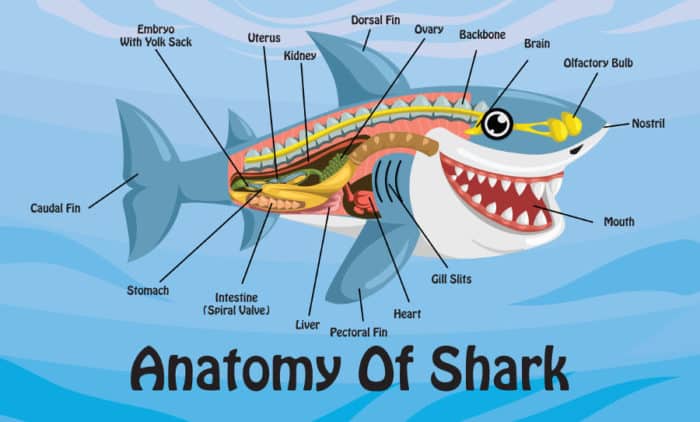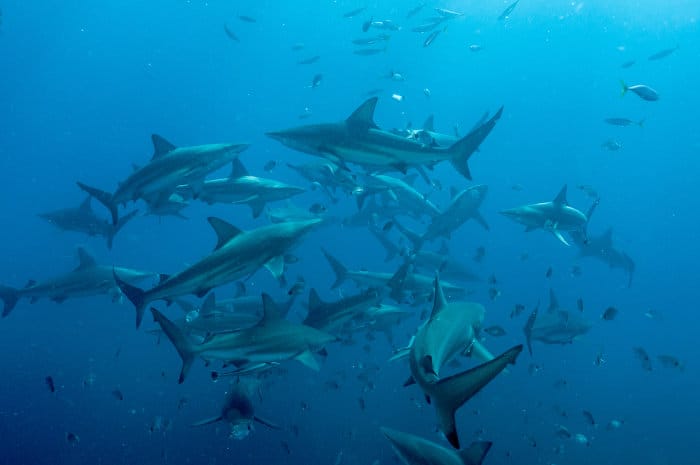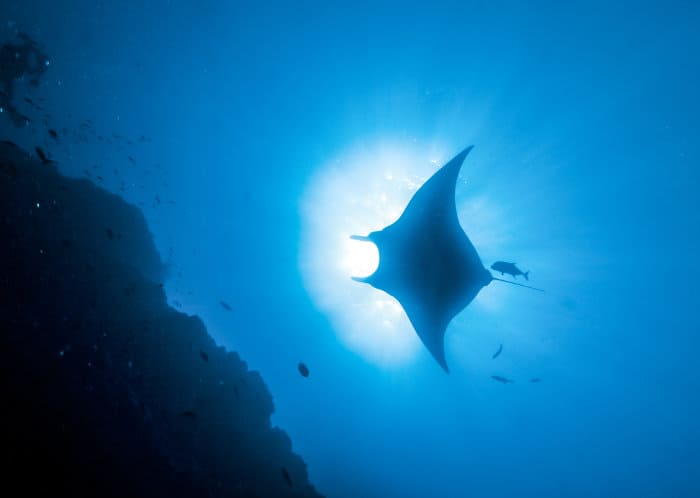If you’ve ever pondered the popular question, “Do sharks have bones?”, you’re definitely not alone.
If you’re curious to know the answer, read on to find out more.
Sharks are magnificent creatures. From the majestic great white to the large and mysterious whale shark, these predators roam the oceans far and wide.
They’re magnificently graceful, and yet a little bit misunderstood.
Thanks to their infamous reputations, there are many questions that humans have about these impressive water creatures. But not many people get close enough to figure out the answers.
Let’s find out if sharks have bones, and if not, what they have instead?
Fact or Fiction: Sharks Don’t Have Bones

It’s true – sharks have no bones, per se. However, that does not mean that they’re as floppy as a jellyfish. They still have sturdy skeletons and are classified as vertebrates.
So what do sharks have instead of bones? In place of the hard bones that other vertebrates have, sharks have cartilage.
Cartilage is softer tissue, more flexible than bone, but still strong enough to hold muscle and skin in place. It’s the same stuff that you find in your ears and nose.
Can you feel it? You can bend and twist your ears much more than you could, say, your arm.
It’s also what makes babies’ bodies so supple. Humans start with cartilage on which our bones eventually ossify as they grow.
That flexibility is how sharks manage to move swiftly through the water, and how they can twist and shake their prey once caught.
How many bones does a shark have?
The obvious answer to this is, of course, none. We’ve already established that sharks don’t have any actual bones.
The amount of cartilage would be hard to count since it’s simply connective tissue. So answering how much cartilage is in a shark is hard to do.
However, it’s easier to answer where a shark has cartilage which will affect how much of the supple substance there is. You’ll find cartilage in a shark’s spine, fins, head, and jaw.
So, larger sharks will have more cartilage than smaller species simply because they have bigger bodies to fill.
Fun Fact: Sharks have no rib cages, not even ones made from cartilage. So if you decided to hug a shark (which isn’t necessarily recommended) it would feel strangely squishy. This would also make living out of the water extremely uncomfortable for sharks!
Why don’t sharks have bones?

There may not be an exact reason why sharks have a boneless skeleton. There is a belief that hundreds of years ago, the ancestors of the modern shark did have bones.
Many scientists believe that sharks have since evolved to have cartilage skeletons rather than dense bone vertebrae.
Over the years, the many shark species developed to better survive in their habitats. This, it seems, resulted in them becoming cartilaginous fish instead.
This evolution likely played a large part in sharks becoming the feared predators that they are today. Without their lightweight, flexible skeletons, they wouldn’t be able to evade their own predators as fast.
Nor would they be such fast swimmers, or be able to catch their prey as quickly and seamlessly as they do.
Do Sharks Have Skeletons?
It may seem confusing, but even though sharks have a lack of bones, their bodies do have skeletons.
A shark skeleton is a bit different from other vertebrate species. Interestingly, most of a shark’s muscles don’t connect to the skeleton.
So, what is a shark’s skeleton made of?
Sharks have cartilaginous skeletons. The skeletons are made up completely of connective tissue and muscle.
The skeletons of sharks are made of cartilage, just like the rest of its body. Some of the cartilage in a shark’s body is firmer and stronger than the rest – almost resembling bone.
In the backbone and jaw, sharks have calcified cartilage. Which is just as lightweight and flexible, but a little sturdier.
Do sharks have vertebrae?

Sharks do have vertebrae. They have a backbone (vertebrae), a spinal cord, and a notochord. This is what makes them vertebrates, just like us humans.
But don’t let the word “bone” confuse you. The difference is that the backbone of a shark is made of – you guessed it – cartilage. While our human backbones are made up of a column of bones.
Pros of having a cartilaginous skeleton
As mentioned above, the general consensus is that sharks evolved to have cartilage rather than bones. But why would this group of marine animals need to evolve in such a way?
Well, there are benefits to having a cartilaginous skeleton.
1. It’s lighter than a bone skeleton – sharks avoid being weighed down by heavier bone density thanks to the lightness of cartilage.
2. It provides better buoyancy – this helps sharks float in water, allowing them to use the least amount of energy to stay afloat in their natural habitats.
3. It creates a thick skin – since cartilage is not as hard and protective as bone, all sharks have thick skin which helps protect them from injury.
4. It’s much more flexible – being all cartilage means sharks can bend, twist, and turn in record-breaking speeds. This makes them the respectable predators that they are.
5. It allows for faster swimming – the combination of a lighter weight, flexibility, and buoyancy allows the shark to swim faster while still conserving energy.
6. It makes jaws more extendable – even though a shark’s jaw contains calcified cartilage, it’s still much more flexible than bone. This gives them the ability to open wide.
7. It allows for a stronger bite force – one of the scariest things about sharks is their massive, powerful bite. This is all made possible by the flexibility in the cartilage.
8. It enables faster healing – a broken bone can take ages to heal. Luckily for sharks, having cartilage means that they heal much faster. It can also mean that it’s easier for them to be injured, though.
9. There’s no size limit – unlike bone, cartilage leaves unlimited room for growth. Which allows sharks and other cartilaginous fish to grow to exceptional sizes.
Essentially, sharks are faster, stealthier, and better at hunting their prey thanks to their evolved cartilaginous skeletons. They’re able to conserve energy while moving through the water and have fewer limits in size, speed, and even depths.
A Few More Fascinating Shark Facts

1. Scientists tell the age of a shark by counting the rings found on its backbone.
2. A group of sharks is known as a shiver, a frenzy, a gam, a herd, or a school.
3. The skin of a shark consists of small denticles, which contain dentin – the same thing found inside your teeth. So instead of scales, they essentially have millions of teeth covering their bodies.
4. These denticles make sharks’ skin feel much like sandpaper.
5. Male sharks often bite the females when mating, so females have much thicker skin.
6. Sharks have red blood cells. Usually, bones produce red blood cells, but in sharks, it’s the spleen and other organs that produce them.
7. A shark’s jaw is not attached to the skull.
8. Sharks have exceptional eyesight.
9. The shape and size of a shark’s teeth depend on their prey. Some are pointed, while others are triangular.
10. The spots on a whale shark are as unique as a human fingerprint.
11. The great white shark is arguably the only shark that can lift its head out of the water to look for prey.
Other Fish Without Bones

Sharks aren’t the only marine life that has cartilage instead of bones. Other cartilaginous fish include stingrays, manta rays, and sawfish. This group of fish is also known as elasmobranchs.
Chimaeras are another group of evolutionary cartilaginous fish. These are related to the shark, ray, and sawfish. Some chimaera fish include the many ghost shark species, the spookfish, and the rabbitfish.
Jellyfish, octopus, and shrimp also have no bones, but these are invertebrates. Meaning they also have no backbone.
Recap on Shark Bones (and the Lack Thereof)
There are hundreds of species of sharks. Some large and some small, all varying in colors and distinctive characteristics. But the one thing they all have in common? Sharks don’t have bones.
So now you can confidently answer that question next time it comes up in a game of 30 Seconds or Trivial Pursuit. Your friends may think you’re wrong, but just show them this post and they’ll soon learn the truth.




Dogfish (small sharks) can certainly raise their heads to look out of the water, as a local aquarium had one that spent its day looking around it, either for its feeders, or just interested in the passers by. Probably the former.
Really interesting, thanks for pointing that out! 🙂